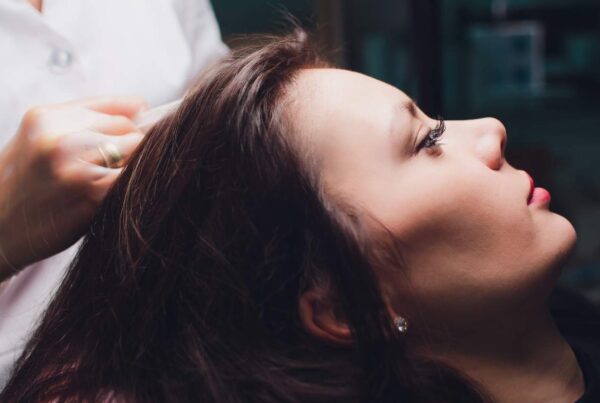How Common Is Hair Loss or Alopecia?
Advances of medicine have lengthened our life expectancy, but this has led to some disadvantages such as baldness or alopecia, more or less severe for each person suffering from it. According to a study by IFOP (French Institute of Public Opinion), this disease affects 13% of the French population, 2% of women and 25% of men. Although this percentage has stabilized since the 1990s, baldness is a major concern for men.
What Causes Alopecia?
Almost 40% of people suffering from baldness say they are concerned about losing their hair, and 5% are even anxious about this idea. However, despite concern regarding this problem, very few people understand the causes of androgenetic alopecia, commonly known as baldness. Among these, genetic predisposition, environmental factors, diet, stress, hormonal disorders, and pathologies.
Thanks to scientific progress, this problem is no longer irreversible. Now those who want to return to show off the hair of youth can do it thanks to hair transplantation.
Starks, a clinic specializing in hair services and age management, tells us how hair implants work and how long they last: What is a hair implant? What are the stages of regrowth of hair implants? What happens during the hair transplant operation? What are the two types of transplant operations? What care should be provided after the procedure?
What is a hair implant?
A hair implant is a set of hair that is taken from a donor area and implanted in a recipient area to fight androgenic alopecia. This technique has been practiced in Europe since the 1950s. Since then, the method has dramatically improved, and various techniques have been developed.
However, it is essential to know that hair implants are only suitable for patients with androgenetic alopecia or with scars caused by injury or burns. They are not ideal for other types of hair loss, such as alopecia areata.
Throughout the hair transplant procedure, patients have a lot of questions about hair implants. How do they work? Keep reading to get the answer from Starks.
How do hair implants work? Regrowth stages
Here are the different stages of hair regrowth after a transplant.
What Are The Side Effects Of Hair Transplant Operations?
- The first week after the operation
- Hair implants are a good solution for fighting baldness. However, the operation is not without side effects. In general, a week after the transplant, the patient experiences an uncomfortable sensation and a slight swelling of the head. It’s nothing to worry about because the surgeon will prescribe painkillers. During this first week, crusts will also appear in the recipient area, which will disappear over time.
- Second week
- In the second week, the donor and recipient areas will change color. Some patients think their hair is already growing back, but be aware that this is not the case.
- Third week
- Hair will appear less thick. This is not a sign of a problem, and it is a normal phase in a hair transplant procedure. This period lasts about two weeks.
- Hair will appear less thick. This is not a sign of a problem, and it is a normal phase in a hair transplant procedure. This period lasts about two weeks.
- One month after the operation
- A month after the procedure, many patients start to panic because the grafts fall out, and they think that the hair transplant has failed. But this is not the case.
- Two months after the operation
- Following the fall of hair implants, the regrowth of transplanted hair begins. It is timid, but the first results are visible.
- Three months later
- The regrowth of new hair continues gradually, but always slow.
- Four to six months after surgery
- During this time, the growth of new hair becomes stronger and stronger. The results are easily seen.
- Seven to nine months after surgery
- Between seven and nine months after the operation, new hair regrowth comes to an end. By this time, all new hair will have grown.
- Ten to fourteen months after the operation
- The regeneration process for your new hair is coming to an end. From this period, you enter the maturation period. The regrowth is now complete. Besides, the result is natural. You can now take full advantage of your new hair.
As Starks explains in the rest of the article, it is essential to follow your surgeon’s recommendations for perfect growth to your new hair after a hair transplant.
In summary, after the operation, it’s okay to see grafts fall out because it’s all part of the process. Once these ten to fourteen months have passed, you can cut your hair whenever you want. These will grow back correctly afterward.
How long do hair implants last?
This is often one of the first questions people interested in hair transplant ask us. This is a legitimate concern as they seek a definitive solution. We can, therefore, reassure them since the hair implants will not fall out and guarantee thick hair for the rest of the patient’s life.
Why? In a nutshell, because hair from the Hippocratic crown is not sensitive to testosterone, which causes androgenetic alopecia on temporal gulfs, top of the head, and frontal area. The hair on the back of the skull continues to maintain a genetic memory after being implanted in the recipient area and, therefore, to grow to maintain its longevity characteristics.
In summary, hair implants last the entire life of the patient, thanks to the conservation of their genetic expression.
The Process of the Hair Transplant Operation
The hair transplant operation consists of taking grafts from the donor area located at the back of the skull, which is called the “Hippocratic Crown” and re-implanting them on the parts of the head that are bare.
For these interested, further details are below:
Initially, the patient is anesthetized locally so that he does not feel any pain during the operation.
Then, depending on the technique used, the surgeon removes a strip of scalp or follicular units one by one. His assistants will then cut the strip and separate the follicular units according to the number of hairs they contain.
These grafts are reimplanted in the areas of the skull that are stripped, respecting the natural order of the hair.
After the operation, the patient receives a care kit and recommendations for taking care of their grafts.
The two types of hair transplant operations
There are two different types of hair transplant operations:
- FUT or transplant of follicular units is the oldest technique. This is the famous strip technique. The surgeon cuts a strip of hairy skin on the back of the skull. The strip is then divided into individual hair transplants. Each graft is implanted in small incisions on the parts of the skull that are affected by baldness. Finally, the back wound on the Hippocratic crown is closed with stitches. The main disadvantage of this technique is that it leaves a scar. However, it is quite small and can be hidden by other hair. Besides, today’s suturing techniques make it even less visible. Unlike the FUE method, the patient is not forced to shave his head before surgery.
- FUE, or the extraction of follicular units, is much milder than FUT. It is a recent technique that is increasingly popular with patients. This is the technique used by the Starks clinic. Thanks to a punching device, it consists of the direct removal of the individual hair grafts, one by one. Unlike the FUT method, hair grafts are implanted in small incisions made in the scalp.
Post-Operation Care
To ensure the success of the operation and the maintenance of extraordinary hair for the rest of life, it is necessary to take care of the grafts first and then of the newly grown hair.
The first shampoo
The first shampoo takes place directly in the clinic since a precise procedure must be followed. It is recommended to do it 48 hours after the operation. The clinic will provide a special shampoo and lotion that will favor the disappearance of the scabs and regenerate the scalp.
Of course, you can also do this first shampoo yourself. In this case, it is essential to follow these steps:
- Apply the lotion: first, gently apply the lotion on the receiving part of the scalp. To distribute the lotion over the entire area, gently tap. Be careful not to rub, or you will risk seeing the grafts fall. Leave on for 40 minutes. In subsequent washes, it is possible to leave the lotion on for just 15-20 minutes. Then rinse the area, starting from the forehead and pouring water with a cup.
- Apply the shampoo: proceed as for the application of the lotion. Above all, do not rub and leave the product to act for 3-5 minutes. Gently rinse your head with warm water.
- Drying the head: to dry the head, do not use cotton but prefer absorbent paper. To remove excess water, gently tap the part, always without rubbing. Finally, you can use a hairdryer by selecting the lowest speed and temperature.
- Wash the donor part: after washing the recipient part, you can go to the donor area. In this part, it is necessary to apply only the shampoo. You can carefully rub this area for 3 minutes. Then apply the lotion and massage gently to absorb the product into the scalp. Leave on for 10 minutes and remove the excess product.
You can repeat this for two weeks. During this time, the scabs will have disappeared. If there are any left, you can gently rub in the direction of the hair to make it fall out, because, after this period, they should all have fallen out.
You can then resume your regular washing habits, but it is essential to carefully choose the type of shampoo that you will use for the rest of your life to maintain your transplanted hair.
Long-term care
Once the treatment is finished, you can switch back to a more classic shampoo. However, you will need to use products that respect your new hair. First of all, avoid products for sale in supermarkets as they are not suitable for your hair.
Starks recommends the use of neutral pH shampoo. Organic products are also a good alternative. The most important thing is to avoid overly aggressive shampoos and those that contain silicone because they tend to weigh down the hair and therefore reduce its volume. If in doubt, do not hesitate to ask your surgeon for advice.
Now you know what hair implants are and how long they last. The results of hair implantation operations are long-lasting, but it takes a whole year to be definitive. The regrowth of new hair takes between ten and fourteen months. Also, it is necessary to take care of the scalp and new hair using first the cleansing products prescribed by the specialist and then shampoo with a neutral pH.
If you are interested in a hair transplant operation, do not hesitate to contact Starks, the age management specialists.




